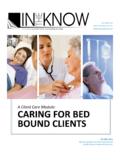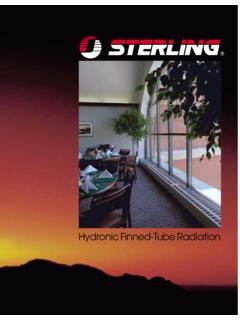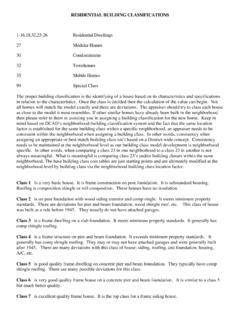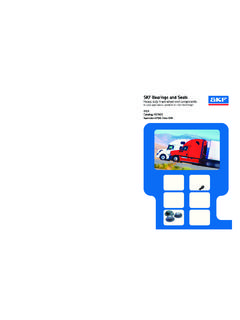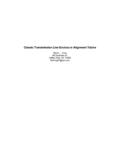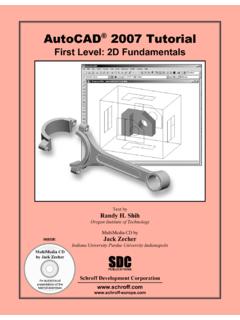Transcription of COMMON CARDIAC CONDITIONS - At Home …
1 A Disease Process Module: COMMON CARDIAC . CONDITIONS . 1998-2013. May be copied for use within each physical location that purchases this inservice topic. Developing Top-Notch CNAs, One Inservice at a Time We hope you enjoy this A Disease Process Module: inservice, prepared by registered nurses COMMON CARDIAC especially CONDITIONS for nursing assistants like you! After finishing this Instructions for the Learner inservice, you will be able to: If you are studying the inservice on your own, please do the following: Describe how a normal Read through all the material. You may find it useful to have a heart functions. highlighting marker nearby as you read. Highlight any information that is . new to you or that you feel is especially important. List the main symptoms If you have questions about anything you read, please ask associated with CHF, CAD, _____. high blood pressure and heart attacks. Take the quiz. Think about each statement and pick the best answer.. Check with your supervisor for the right answers.
2 You need 8 correct Detect and respond to pass! appropriately to symptoms of edema, angina and heart Print your name, write in the date, and then sign your name. attack. Keep the inservice information for yourself and turn in the quiz page to . _____ no later than _____. Help clients choose Show your Inservice Club Membership Card to _____ so behaviors that decrease that it can be initialed. their risks for developing CARDIAC CONDITIONS . Email In the Know at with your comments and/or suggestions for improving this inservice.. Demonstrate skills that prevent, treat and manage THANK YOU! CARDIAC CONDITIONS in your daily work with clients. Developing Top-Notch CNAs, One Inservice at a Time Inside This A Disease Process Module: Inservice: COMMON CARDIAC CONDITIONS Anatomy of the Heart 2. THE FACES OF HEART DISEASE. Congestive Heart 3. Meet Rita. Rita didn't know that the occasional Failure (CHF). fatigue and nausea she felt could be symptoms of Coronary Artery 4 heart disease.
3 She didn't have any of the classic signs and didn't know the more subtle symptoms COMMON Disease (CAD). to women. Besides, they were there one day and gone Hypertension 5 the next. Heart Attacks 6 Fortunately, Rita had a routine EKG for an unrelated medical procedure that showed an abnormal heart Edema and Arrhythmias 7 rhythm and a blockage in an artery supplying blood to her heart muscle. Endocarditis and Valve 8 And this is Frank. Frank was doing some yard work Disease when he felt tightness in his chest. He convinced himself it wasn't serious, but his pacemaker told a Keeping the Heart 9 different story. Healthy Frank's pacemaker recorded the event which alerted his Final Thoughts! 10 doctor to perform some tests. The tests revealed that Frank had a blockage in a blood vessel putting him in danger of having a heart attack. Ron's Heart Attack. Ron and his wife got in their car to go have dinner with their daughter. But they only made it as far as the end of the driveway.
4 That's when Ron suddenly slumped over, unconscious in his seat. His wife drove to the nearest hospital, where he received CPR in the parking lot before being rushed inside. Soon, he was being airlifted to a nearby 2013 In the Know, Inc. hospital for emergency heart surgery. May be copied for use within each physical location that Keep reading to learn all about the things that can go wrong with the heart. purchases this inservice from You'll learn about the problems that Rita, Frank and Ron experienced and In the Know. All other you'll learn what you can do to help. You also discover that many of the copying or distribution is COMMON CARDIAC CONDITIONS we see today can be prevented, and you play a strictly prohibited. major role in helping clients prevent COMMON CARDIAC CONDITIONS ! 2013 In the Know, Inc. Page 2. A CLOSER LOOK AT THE HEART. Aorta Superior Vena Cava Pulmonary Veins Left Atrium Right Atrium Tricuspid Valve Bicuspid Valve Left Ventricle Right Ventricle Pulmonary Valve Aortic Valve Pulmonary Artery Follow Blood's Path Through the Heart De-oxygenated blood (blood that has dropped off The oxygenated blood re-enters the heart through its oxygen to places in the body) enters the heart the PULMONARY VEINS.
5 Through the SUPERIOR VENA CAVA. The blood stops to collect in the LEFT ATRIUM. The first stop is the RIGHT ATRIUM. When the left atrium becomes full, the BICUSPID. When the right atrium becomes full, the VALVE opens, sending the blood into the LEFT. TRICUSPID VALVE opens, allowing the blood to VENTRICLE. enter the right ventricle. When the left ventricle becomes full, it contracts When the right ventricle becomes full, it contracts with enough force to push the blood up though (squeezes) and pushes the blood through the the AORTIC VALVE into the aorta. pulmonary valve into the pulmonary artery. Oxygenated blood in the AORTA is pushed out of The PULMONARY ARTERY carries blood out of the the heart and into the body so it can deliver heart, into the lungs, to pick up oxygen. oxygen to every body part and organ. Grab your favorite highlighter! As you read this inservice, highlight five things you learn that you didn't know before. Share this new information with your co-workers!
6 2013 In the Know, Inc. Page 3. SPOTLIGHT ON CONGESTIVE HEART FAILURE (CHF). WHAT IS CHF? SIGNS AND SYMPTOMS OF CHF: The heart has two jobs .. Fatigue Fatigue is often the first symptom of CHF. However, it usually goes unreported until it The first job is to continuously pump the de- becomes severe. oxygenated (used) blood to the lungs to pick Dyspnea (Shortness of Breath) Dyspnea is up oxygen. another early symptom of heart failure. It can The second job is to pump that freshly happen: oxygenated blood out of the heart and into At rest, while just sitting and relaxing. the entire body to nourish all those muscles On exertion, while doing routine activities like and organs. walking or housework. With heart failure, oxygenated blood enters the left When lying down. These clients will often side of the heart from the lungs, but the ventricle sleep sitting up in a chair. can't pump hard enough to push all the blood out to the body, so some is left behind. (Refer back to page 2 Sudden Weight Gain It is not unusual for to see where this is happening.)
7 People with CHF to gain weight in a short period of time due to fluid retention. The blood backs up, causing fluid to leak back Edema Edema is swelling, especially in the legs, into the lungs. This is known as feet and abdomen. LEFT-SIDED HEART FAILURE. When fluid backs up into the HOW YOU CAN HELP: lungs, the client will have Check Daily Weight Weigh your clients on difficulty breathing. This is called the same scale, at the same time of day, and pulmonary congestion. wearing the same amount of clothing to check for increasing congestion and edema. Heart failure can happen on the right side, too. Blood enters the Monitor vital signs closely Medication right ventricle as it should, but the doses will be adjusted daily based on ventricle can't pump hard enough blood pressure results taken by you. Be to get the blood into the lungs, so sure to get accurate and timely results, some is left behind. This is called and report your findings to the nurse. RIGHT-SIDED HEART FAILURE.
8 Respiratory rates should be assessed The kidneys respond by causing the accurately and on time. Any respiratory body to retain water and sodium. rate that falls outside the normal range Fluid builds up in the legs, ankles, of 12-20 should be reported and feet. This is called edema. (You'll immediately. learn more about edema on page 7.) Record strict I & O People with CHF. who take in more fluids than they excrete The body becomes congested with will develop edema. fluid. This is why it is called congestive heart failure. Plan for rest and breaks Alternate periods of activity with periods of rest. Over time, blood left behind stretches Avoid rushing your CHF clients and allow the ventricles, and they become even for periodic rest breaks. (Plan for ten to weaker, like a worn out rubber band. fifteen minutes of rest for every hour or two of activity.). 2013 In the Know, Inc. Page 4. SPOTLIGHT ON CORONARY ARTERY DISEASE (CAD). WHAT IS CAD? SIGNS AND SYMPTOMS OF CAD: The heart pumps blood (which carries oxygen) all over The most COMMON symptom of CAD is angina.
9 The body. It travels through the arteries. Every part of Angina simply means chest pain. Most people the body needs oxygen, including the muscles of the describe angina pain as a feeling of pressure or heart. tightness in the chest, neck, jaw, shoulder or arm. Someone with CAD has a problem with blood Signs that your client is having chest pain from flow in the arteries that carry oxygen to the angina include: muscles of the heart. Rubbing the left side or middle of the chest. People with CAD have a disease that gunks up the arteries called atherosclerosis (say: ath-uh-row-skluh- Complaining of pain in the left arm, neck or left row-sus). (You can learn more about atherosclerosis in side of the jaw. our inservice on COMMON Vascular CONDITIONS .). Sweating. Without treatment, the artery may narrow (not allowing enough blood to flow through, or it can Pale skin. become blocked all together and NO blood will get Feeling dizzy. through. Having trouble breathing. If blood cannot get to the heart, the area that is not getting the blood will die.)
10 This is a heart attack. (More on heart attacks on page 5 of this inservice.). HOW YOU CAN HELP: Medication Clients with angina WHAT CAUSES CAD? will have a medication called There are two types of risk nitroglycerin. It might be a tablet, a factors for CAD those that can patch or even a spray. be controlled and those that Nitroglycerin causes the arteries to cannot. relax and open so blood can flow. Factors that cannot be In facilities, report your client's controlled include age (being symptoms of angina right away so over 65), race (white, middle- medication can be administered. aged men are the largest group In home care, you are not of people who have CAD), and allowed to give any medications. family history of heart disease. But, it may be helpful for you to go Factors that can be controlled include: and get your client's medication so High cholesterol: This is the number one he or she can take it. cause of CAD. Rest Exercise, stress and becoming too excited can High blood pressure: High blood pressure cause the pain to start.
